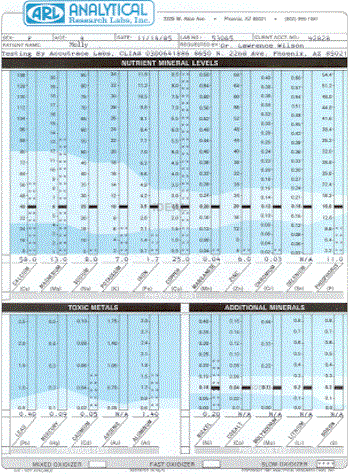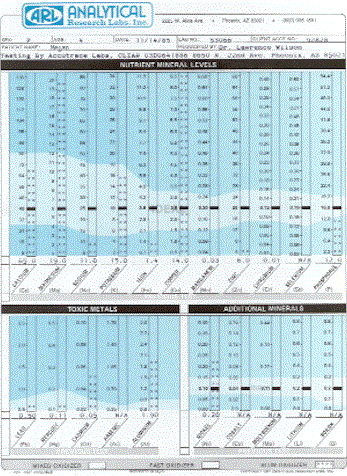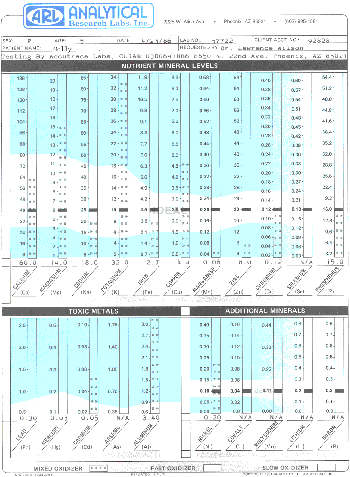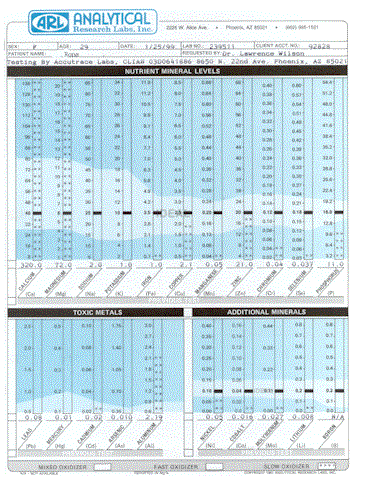Positive Health Online
Your Country

Hair Mineral Analysis
by Lawrence Wilson, MD(more info)
listed in nutrition, originally published in issue 43 - August 1999
Achieving harmony and balance is a basic principle of healing. This principle applies in many ways, including the balance of the minerals in the body. Minerals are the "stepchildren of nutrition". Often ignored for more glamorous nutrients, they are so precious and vital for our well-being. Minerals play many roles in the human body, from regulating fluid balance to activating genes and hormones. Thousands of enzymes depend on minerals as components, or as activators, facilitators or inhibitors.

Figure 1 Molly's First Mineral Test
What is the best way to measure minerals in the body? Doctors often use blood tests. However, blood mineral levels are kept within a very tight range, even in many illnesses. An alternative is to measure minerals directly in the body tissues or cells. The cells, not the blood or urine, are the main site of metabolism. Mineral levels are higher in the cells than in the blood, making measurement easier. Toxic minerals concentrate in the tissues, but are quickly removed from the blood. A body tissue that is painless to sample, and easy to store and transport, is the hair.
Testing The Hair
Hair makes an excellent biopsy material. The hair tissue is dead and the minerals are locked inside, leaving a clear record of the hair metabolism. Mineral imbalances show up much sooner in the hair than in the blood. This is because the blood is maintained at the expense of the tissues. That is, minerals are pulled out of the tissues to maintain the blood levels. For this reason, serum mineral levels often appear normal even if one is ill.
The problem with hair analysis is, what do all the numbers mean? If a mineral level is elevated in the hair, does it mean it is also high in other parts of the body? Perhaps it is being excreted through the hair, lost through the hair, stored in the hair, or is the mineral just normally deposited there?
Dr. Paul Eck was a pioneer in hair mineral testing. The author was fortunate to have worked closely with him for 14 years. Over years of research, Dr. Eck incorporated the stress theory of disease, metabolic typing, natural healing theory and modern biology to help interpret the test. While this is a research area, the author's experience confirms that the test can provide information about your energy level, immune system, carbohydrate tolerance, emotional balance, and glandular activity. Mineral testing can also help reduce the guesswork in recommending diets and nutritional supplements. It can also be used to monitor metabolic changes as a result of any form of therapy.
How Is The Test Performed?
Several snips of clean hair are cut close to the scalp. The ends over three millimetres long are cut off and thrown away, as these would give an old reading. The testing laboratory requires about a tablespoon of hair.
Laboratory technicians cut the sample into small pieces and dissolve it in acid overnight. A carefully measured amount is then burned in a computer-controlled spectrometer. Each mineral gives off characteristic colours or spectra, which are read by sensitive detectors. The test measures the:
* Macrominerals – calcium, magnesium, sodium, potassium and phosphorus;
* Trace minerals – zinc copper, iron, manganese, chromium, selenium, silicon and others;
* Toxic metals – lead, mercury, cadmium, arsenic, aluminium, nickel, and others.
The test provides a reading of the minerals deposited in the cells and interstitial spaces of the hair over a 2-3 month period. It does not provide an assessment of the mineral content of other tissues of the body. However, testing the hair can allow one to infer what is occurring in other tissues of the body.
Hair analysis is considered a screening test. It is a relatively simple, easily-performed test designed to provide a lot of information rapidly and inexpensively. Screening tests are often undervalued in health care.
A Case History: Infections, Seizures And Learning Disorders
An excellent way to introduce mineral balancing is with case histories. Molly and Megan, age four, are identical twins. Both had a history of chronic infections, with frequent coughs, bronchitis and earaches which often progressed to febrile seizures. Teachers also suspected a learning disorder. The four-year-old twins were often prescribed antibiotics for the infections. They also took Phenobarbital and Dilantin to control seizures.

Figure 2 Megan's First Mineral Test

Figure 3 Moly's Retest Mineral Analysis

Figure 4 Megan's Retest Mineral Analysis
The twins' hair analyses (see Figures 1, 2, 3 and 4) reveal mineral imbalances associated with a low energy level, seizures, and a reduced ability to resist infections. Before discussing the specifics, note how similar the charts are to each other. This is probably because the twins are identical, and living in the same household. It also reflects the accuracy of the test, as the patterns are rather unusual.
The Critical Ratios. A key principle in hair analysis interpretation is to examine mineral ratios. Ratios represent relationships and balances in the body. On the girls' charts, two key ratios, sodium-to-potassium and calcium-to-magnesium, are very low. These ratios are very important for health. A low sodium-to-potassium ratio is associated with a compromised immune system and lowered energy level. It is also associated with adrenal weakness, and a tendency for carbohydrate intolerance.
An unbalanced calcium-to-magnesium ratio is associated with carbohydrate intolerance, often caused by a diet that is too rich in carbohydrates. This upsets body chemistry, interferes with energy production, and sets the stage for many symptoms.
Zinc and Copper. Both twins show low levels of zinc. Adequate tissue zinc is important for the immune system, for digestion and for the repair of all body tissues. Zinc also has a calming, anti-seizure effect on the central nervous system.
Both twins have very elevated copper levels. Copper antagonises or interferes with zinc. Elevated tissue copper is associated with a tendency for seizures and infections. Copper imbalance can also affect the thyroid gland, the nervous system, the skin and other body systems. Many children today have high tissue copper levels due to weak adrenal glands or passed on to them from parents with elevated copper.
Cadmium. Both twins' tests reveal elevated levels of cadmium, a highly toxic metal. Cadmium antagonises or interferes with zinc. Cadmium may replace zinc in vital enzyme binding sites, impairing the function of zinc-dependent enzymes. Cadmium toxicity may contribute to immune system dysfunction and possibly to seizures.
Cadmium is found in smoke from cigarettes and marijuana, junk food and tap water. Some industrial workers may be exposed to cadmium. In four-year-old children, cadmium probably came from their mother, passed to them through the placenta. Children today are often born with high levels of toxic metals due to the eating and living habits of their parents and even grandparents.
Aluminium and Nickel. Both girls also have elevated aluminium and nickel levels. Aluminium toxicity is a common finding on hair mineral tests. Aluminium is widely distributed in the environment. Common sources include food cooked in aluminium cookware, beverages from aluminium cans, antiperspirants and antacids. However, aluminium is also added to table salt, drinking water, and baking powders. Peppermint and spearmint tea, and to some degree regular tea, are high in aluminium.
Excessive tissue aluminium is associated with memory loss, dementia and possibly learning disorders in children. The girls probably got aluminium from their mother. Fortunately, aluminium is fairly easy to remove from the tissues unless dementia has set in. Note that the aluminium level of both twins increased on the retests. This indicates an active elimination through the hair, and is a common finding. After the elimination, the levels decrease.
Nickel toxicity is less common. Sources include hydrogenated oils found in margarine, commercial peanut butters and vegetable shortening. In adults, dental materials and occupational exposure to metals may also raise the nickel level.
Balancing Body Chemistry. Both girls were placed on a dietary and supplement program to balance their mineral levels and ratios. In this instance, the diet included a reduced amount of sweets and carbohydrates, low-fat protein with each meal, more vegetables, and fresh, high-quality food. Nutritional supplements included vitamins A, B-complex, C and E, and manganese, zinc, calcium and magnesium in the proper dosages to balance the ratios.
Within four months, both girls stopped wetting the bed and stopped coughing completely. Neither had any more infections or seizures. After a year had passed, their mother reported that previously they had visited the doctor's office about once a week for one problem or another. Since beginning the nutrition program, the twins had not required a doctor even once.
Case 2. Depression, Fatigue, Tooth Decay, Acne, Yeast Infections And Pre-menstrual Tension
This case (see Figure 5) illustrates common mineral patterns in young adults. Rona is 29, and follows a natural food, mostly vegetarian, diet. She is often tired, and has allergies, gas and bloating, acne, cravings for starches and fats, and some depression and PMS.

Figure 5 Rona's Mineral Test
Slow Metabolism. A dominant pattern on Rona's test is her very high calcium and magnesium levels combined with very low sodium and potassium levels. This pattern is associated with a sluggish metabolic rate or oxidation rate. Oxidation refers to the burning of food. The hair must not be washed at the laboratory to provide accurate sodium and potassium readings.
Slow oxidation is associated with reduced adrenal glandular activity at the cellular level. Weak adrenals may contribute to low blood pressure, low energy, allergies, chronic low blood sugar, and an excessively alkaline body chemistry that increases susceptibility to yeast infections. The adrenal hormones, cortisol and adrenalin, help prevent allergies and raise the levels of blood sugar and blood pressure.
Conditions such as allergies, asthma, arthritis and others may have very different causes depending on the body chemistry. Correction is far more successful when the cause is ascertained, instead of guessing and using symptomatic nutrition or symptomatic herbs or drug therapy.
Calcium and Magnesium. Rona's calcium level is eight times normal! This can be confusing, as it does not mean she has an excess of calcium or magnesium in her body. Quite the opposite! She is losing these minerals through her hair. The phenomena is called biologically unavailable calcium. In these cases, calcium precipitates into the tissues, instead of remaining in the blood. This can cause a combination of symptoms of calcium excess such as joint stiffness, and calcium deficiency such as leg cramps, irritability and later in life, osteoporosis.
The 'Calcium Shell'. A very high tissue calcium level is associated with feelings of depression. Calcium stabilises cell membranes and increases the voltage required for nerve cells to fire. It literally depresses the functioning of the nervous system. When calcium is over 200 mg% (milligrams per 100 grams), as in this instance, it is called a 'calcium shell' pattern. It is associated with psychological withdrawal, and at times a lack of awareness. Often these individuals are very sensitive to stress, overwhelmed by stress, or not proficient at coping with stress.
Low Sodium and Potassium. Rona eats plenty of potassium foods and uses some salt. Yet her sodium and potassium levels are very low! The adrenal hormone aldosterone retains sodium in the body. Rona is urinating out too much sodium and potassium. Low hair sodium is associated with low energy, and with deficient gastric hydrochloric acid that may impair protein digestion.
Rona's ratio of sodium to potassium is also low. The normal ratio is about 2.5:1. Her ratio is 2:1. This is another fatigue and weak adrenal indicator.
Low Phosphorus. Phosphorus is low on this test. Phosphorus is a component of protein. A low level often means that protein synthesis is inadequate. This may be due to a diet deficient in high-quality protein, impaired protein digestion or absorption, or a zinc deficiency. Zinc is needed for digestive enzyme formation and for protein synthesis. Low hair phosphorus may be associated with impaired digestion, an irritable colon, and often vegetarian diets. While some people are healthy on vegetarian diets, many do not feel well on these diets.
Hidden Copper Imbalance. A high hair calcium with a low hair potassium is associated with a copper imbalance. This is so even if the hair copper level is in the normal range, as in this case. Copper imbalance is associated with acne and pre-menstrual tension. In fact, the symptoms of copper imbalance are identical to the symptoms of pre-menstrual tension. The copper level tends to correlate with the level of oestrogen in the body. Copper imbalance tends to accentuate the emotions, and can contribute to depression, mood swings and irritability.
Correction. Rona was advised to change her diet to include more protein, preferably some animal protein as it is higher in zinc and lower in copper. She feels better taking digestive enzymes and acidophilus to assist digestion until her body chemistry becomes better balanced. Other nutritional supplements recommended included B-complex vitamins, as these may help increase the metabolic rate.
She received adrenal support including vitamins A, C, E and adrenal glandular substance, and chelated calcium, magnesium, manganese and chromium. While deep healing may require months, within a week on this regimen Rona reported feeling "so much better", with more energy, improved digestion and a more positive outlook on life.
Here are some commonly asked questions about hair mineral testing.
How Accurate Is Hair Testing?
When performed correctly, which includes not washing the hair at the laboratory, mineral analysis is as accurate or more so than standard blood tests. Some hair testing laboratories wash the hair with detergents or acetone for three to ten minutes. Research indicates this is unwise. Washing erratically removes up to 50% of the water-soluble minerals. Always ask about this, and I suggest avoiding these laboratories.
Commercial hair testing laboratories are inspected by the government, and must adhere to the same standards as blood laboratories. Often they are under greater scrutiny because the test is less conventional.
Can Hair Analysis Help Emotional Problems?
A mineral analysis can help identify nutritional causes for depression, anxiety, irritability, moods swings, phobias, attention deficit, and even violence and some forms of schizophrenia. How is this possible?
The brain is a chemical organ. It depends on a balance of hundreds of nutrients for its functioning. Nutrients including copper, zinc, manganese and the vitamins affect cognition, neurotransmitter levels and nerve cell activity. Toxic metals such as lead, mercury and cadmium profoundly affect the brain. The 'mad hatters' of Alice in Wonderland were poisoned by mercury, a common problem in the felt hat industry a hundred years ago.
It should be no surprise that a test for cellular minerals can indicate tendencies for emotional and mental conditions. In practice, mineral balancing is helpful for many emotional difficulties, and may enhance the response to psychotherapy and other emotional therapies.
Isn't Hair Contaminated By Shampoo, Tints Or Hair Dyes?
Most hair products do not contain minerals that remain in the hair, and therefore do not affect the test. Neither does normal showering, light sweating and air pollution, unless one works in a heavily contaminated environment. Hair is not very porous, about 10% in men and 15% in women. The following can affect hair readings:
* Daily swimming in pools can raise sodium and copper levels;
* Heavy sweating immediately before cutting the sample can raise sodium and potassium readings;
* 'Grecian Formula' and 'Youth Hair' hair dye contain lead. They will elevate the lead level (and should be avoided)!
* Head & Shoulders shampoo can elevate the zinc level;
* Selsun Blue shampoo can elevate the selenium level;
* Bleaching and permanents can affect hair readings.
Asking the client which products are on their hair will usually be sufficient to rule out abnormal readings due to hair products. If possible, take a hair sample before having a permanent or bleaching. After these treatments, it is best to let the hair grow out for a few weeks, and wash the hair 4-5 times before taking a hair sample. However, if a person is very ill, a sample can be taken at any time. It may not be perfectly accurate, but will provide enough information to begin a corrective programme.
Is Hair Analysis Documented?
Hundreds of papers have been published on the subject of tissue mineral testing. Spectrographic analysis is a standard testing method used at laboratories and universities around the world.
The United States Environmental Protection Agency published a 300-page study in August 19791. They reviewed over 400 medical reports on hair testing. The authors concluded that hair is a "meaningful and representative tissue for biological monitoring for most of the toxic metals". Lists of medical references for hair analysis are found in textbooks such as Nutritional Balancing and Hair Mineral Analysis2 and Trace Elements, Hair Analysis and Nutrition3.
Very few physicians are trained in hair mineral analysis. Often they will comment about it out of ignorance. The author was very skeptical about hair mineral testing. Clinical experience with over 10,000 clients dispelled his doubts.
Hair analysis has been tainted by some poorly conducted studies. One was printed in the Journal of the American Medical Association in August 1985. Fifty-six samples were sent to 13 different laboratories, and the results analysed for consistency. Four of the thirteen labs performed very well. Another three performed moderately well. The author, however, overlooked these positive results and claimed that all hair analysis was probably a fraud. The study was well-publicised.
In this study, standard hair analysis protocol was violated in several ways, any one of which would be enough to discredit the study. Long strands of hair were used, and cut into small pieces. The ends of long hair are old, subject to contamination, and should never be used. Also, the samples were washed under the tap before being sent to the laboratory. This contaminates the sample. If the hair is washed while on the head, the mineral levels re-equilibrate after showering. This is not possible once the hair is cut.
Tissue mineral testing is also misunderstood due to other design errors in medical studies. For example:
* Studies of a single mineral often miss the fact that all the minerals interact. They are part of a mineral system. Only when viewed as a system do hair test results make much sense;
* Studies that address whether feeding a mineral causes that mineral to rise in the hair are often inconclusive. These studies miss the point that the hair represents the state of body chemistry, which is only partially determined by ingestion of any mineral or food;
* Some laboratories wash the hair. This will affect the readings, and cause conflicting results if samples are sent to several laboratories for comparison;
* Some studies of hair analysis involve replacement therapy, which does not work well! Replacement therapy is the attempt to correct body chemistry by simply recommending the minerals that are low on the test. This method can lead to confusing and conflicting results.
How Can Hair Analysis Be Used To Recommend Vitamins?
Some criticise hair mineral testing when it is used to recommend foods and supplements, particularly vitamins which are not even tested. The answer is that vitamin and food needs may be inferred from test results. For example, vitamin C, garlic and sulphur amino acids help remove toxic metals from the body. It is a matter of common sense to recommend these products if toxic metals are revealed on the mineral test.
In the author's experience, hair analysis is excellent for assessing some nutritional needs, provided the test is performed and interpreted correctly. The test helps one create a metabolic blueprint of the state of body chemistry. It is then possible to recommend with some accuracy diet, lifestyle changes and supplements that may lead to dramatic improvements in health and well-being.
Courses
A distance learning course on hair mineral analysis is offered by Westbrook University, University Plaza, 120 Llano Street, Aztec, NM 87410, USA; phone:(505) 334-1115; web site: www.westbrooku.edu.
References
1. Toxic Trace Metals in Mammalian and Human Hair and Nails, EPA-600 4.049, August 1979, U.S. Environmental Protection Agency, Research and Development. This is a review of 400 studies on hair analysis and toxic metals.
2. Nutritional Balancing and Hair Mineral Analysis, L. Wilson, L.D. Wilson Consultants, Inc., Prescott, AZ, 1992, 1998. A newly revised text discusses the theory, interpretation and clinical application of tissue mineral analysis.
3. Trace Elements, Hair Analysis and Nutrition by R.A. Passwater and E. Cranton, Keats Publishing, New Canaan, CT, 1983. This is an older textbook, and mainly theoretical.
4. Analytical Research Laboratories, P.O. Box 37964, Phoenix, Arizona 85069, USA; Phone: (602) 995-1580. An excellent laboratory with bulletins, seminar tapes, articles and books on mineral analysis.
5. The world wide web has many hair analysis sites. There are different approaches to the subject, and very different levels of expertise and experience.
Comments:
-
Norimasa Fujiyama said..
Nice to meet you, my name is Norimasa Fujiyama.
I am the owner of a Japanese company.
I am looking for a business partner of the hair mineral test .
Please tell me some wholesale price.
Is the hair mineral test of the dog possible, too?
I am waiting for a good answer.
-
Holley ryan said..
I would like to have this testing done. Can you please recommend a reputable lab. I am located in Virginia, about one hour from Washington, DC. Thank you.